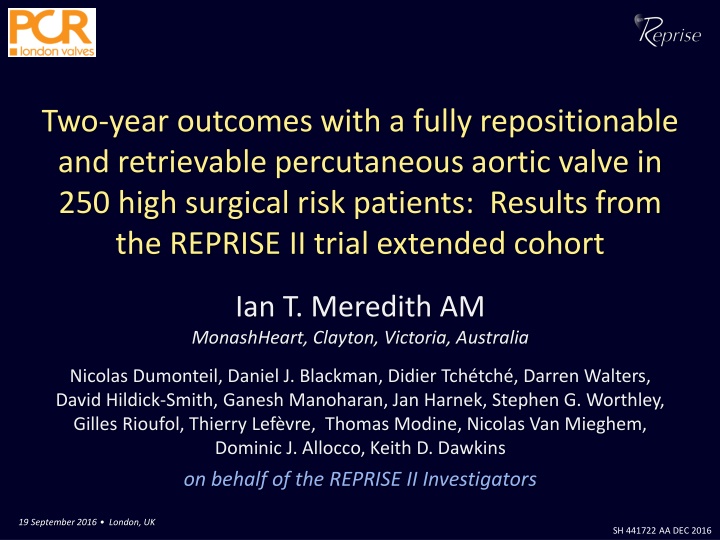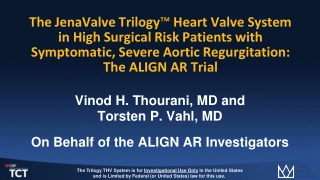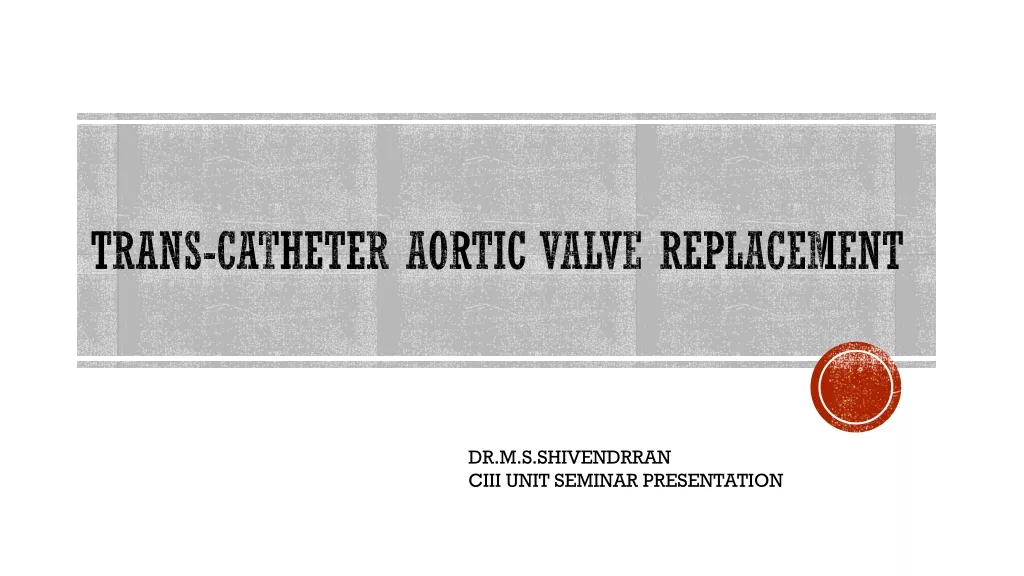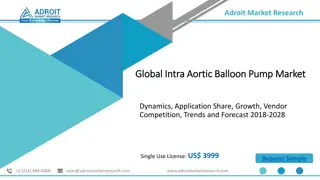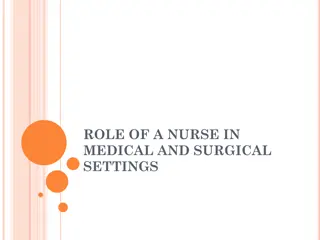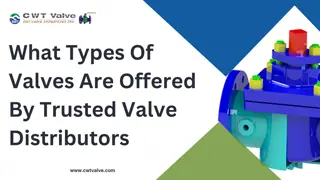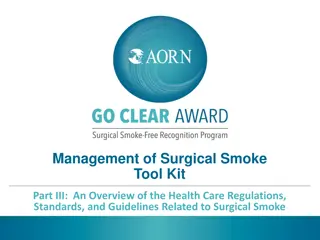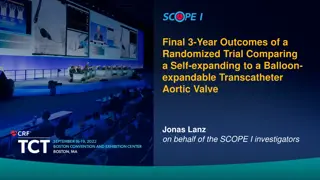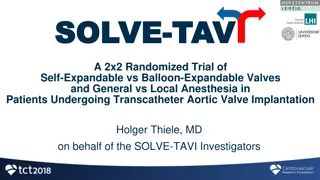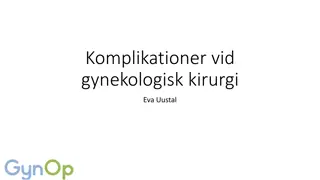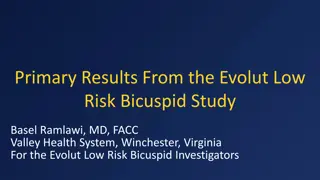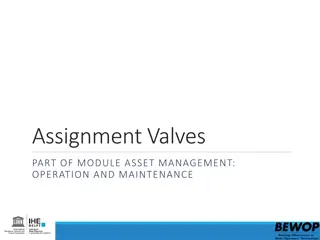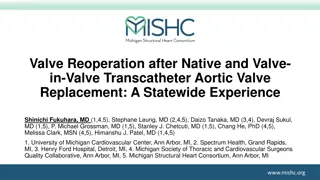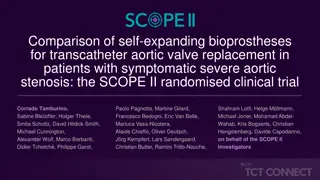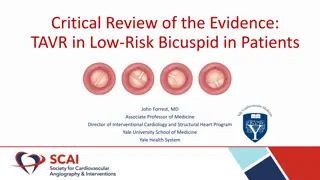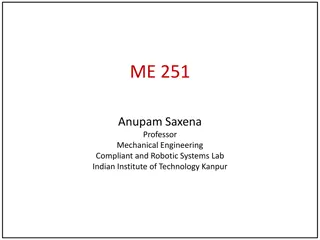Two-Year Outcomes with Fully Repositionable Aortic Valve in High Surgical Risk Patients
The REPRISE II trial extended cohort evaluated the Lotus Valve System's safety and performance in symptomatic patients with severe aortic stenosis at high risk for surgical valve replacement. This prospective, single-arm study assessed the valve system's effectiveness through various follow-ups and independent data assessments. PRINCIPAL INVESTIGATOR: Ian T. Meredith, AM.
Download Presentation

Please find below an Image/Link to download the presentation.
The content on the website is provided AS IS for your information and personal use only. It may not be sold, licensed, or shared on other websites without obtaining consent from the author.If you encounter any issues during the download, it is possible that the publisher has removed the file from their server.
You are allowed to download the files provided on this website for personal or commercial use, subject to the condition that they are used lawfully. All files are the property of their respective owners.
The content on the website is provided AS IS for your information and personal use only. It may not be sold, licensed, or shared on other websites without obtaining consent from the author.
E N D
Presentation Transcript
Two-year outcomes with a fully repositionable and retrievable percutaneous aortic valve in 250 high surgical risk patients: Results from the REPRISE II trial extended cohort Ian T. Meredith AM MonashHeart, Clayton, Victoria, Australia Nicolas Dumonteil, Daniel J. Blackman, Didier Tch tch , Darren Walters, David Hildick-Smith, Ganesh Manoharan, Jan Harnek, Stephen G. Worthley, Gilles Rioufol, Thierry Lef vre, Thomas Modine, Nicolas Van Mieghem, Dominic J. Allocco, Keith D. Dawkins on behalf of the REPRISE II Investigators 19 September 2016 London, UK SH 441722 AA DEC 2016
Disclosures Ian T. Meredith AM Consultant Fee / Honoraria / Speaker s Bureau: Boston Scientific (Significant) The REPRISE studies are sponsored and funded by Boston Scientific Corporation. SH 441722 AA DEC 2016
Lotus Valve System Fully repositionable & retrievable Controlled mechanical expansion for precise placement Early valve function enables hemodynamic stability Braided Nitinol Frame Adaptive Seal designed to minimise PVL Radiopaque Positioning Marker Bovine Pericardium Leaflets Information not intended for use in France. Lotus is an investigational device and not for sale or distribution in the US. CE mark received 2013. Information for the Lotus Valve System is for use in countries with applicable product registrations. Indications, contraindications, warnings and instructions for use can be found in the product labeling supplied with each device. SH 441722 AA DEC 2016
REPRISE II Study with Extended Cohort OBJECTIVE Evaluate safety & performance of the Lotus Valve System for TAVI in symptomatic patients with severe calcific aortic stenosis considered high risk for surgical valve replacement DESIGN Prospective; single-arm; multicentre Available valve sizes: 23mm & 27mm F/U at 7 days/discharge, 30 days, 3 & 6 months, annually 1 5 years INDEPENDENT DATA ASSESSMENTS Clinical Events Committee Core Labs: Angiography, ECG, Echocardiography, Pathology SH 441722 AA DEC 2016
REPRISE II Study Organisation PRINCIPAL INVESTIGATOR Ian T. Meredith, MBBS, PhD, Monash Medical Centre, Clayton, Australia CORE LABORATORIES Jeffrey J. Popma, MD (Director) Harvard Medical Faculty Physicians at Beth Israel Deaconess Medical Center, Boston, MA, USA Angiography & CT/X-ray Echocardiography Neil J. Weissman, MD (Director) MedStar Health Research Institute, Washington, DC, USA Electrocardiography Peter J. Zimetbaum, MD (Director) Harvard Clinical Research Institute, Boston, MA, USA Pathology Renu Virmani, MD (Director) CV Path Institute, Inc., Gaithersburg, MD, USA CLINICAL EVENTS COMMITTEE Gregory Smaroff, MD (CT Surg) Roberto Rodriguez, MD (CT Surg) Viken Babikian, MD (Neurologist) Sergio Waxman, MD (IC, Chair) Carey Kimmelstiel, MD (IC) SH 441722 AA DEC 2016
Enrollment REPRISE II with Extended Cohort 250 patients between Oct 2012 & Apr 2014 at 20 sites Patients Patients Ian Meredith Monash Medical Centre, Clayton, Australia Thierry Lef vre Institut Cardiovasculaire - Paris Sud, Massy, France 38 9 Nicolas Dumonteil Centre H pital Universitaire Rangueil , Toulouse, France Thomas Modine CHRU Lille - H pital Cardiologique, Lille, France 29 9 Daniel Blackman The General Infirmary, Leeds, UK Nicolas Van Mieghem Erasmus Medical Center, Rotterdam, The Netherlands 22 8 Didier Tch tch Clinique Pasteur, Toulouse, France R diger Lange Deutsches Herzzentrum Muenchen, Muenchen, Germany 21 4 David Hildick-Smith Royal Sussex County Hospital, Brighton, UK Robert Whitbourn St. Vincent's Hospital (Melbourne), Fitzroy, Australia 19 4 Ganesh Manoharan Royal Victoria Hospital, Belfast, UK Simon Redwood Guys and St. Thomas NHS Foundation Trust, London, UK 19 3 Darren Walters The Prince Charles Hospital, Brisbane, Australia Corrado Tamburino Ospedale Ferrarotto, Catania, Italy 19 3 Jan Harnek University Hospital of Lund, Lund, Sweden Ralf M ller HELIOS Klinikum Siegburg, Siegburg, Germany 16 2 Stephen Worthley Royal Adelaide Hospital, Adelaide, Australia Eulogio Garcia Hospital Clinico San Carlos, Madrid, Spain 13 1 Gilles Rioufol H pital Cardiologique de Lyon, Bron, France Stephan Windecker Universit tsspital Bern, Bern, Switzerland 10 1 SH 441722 AA DEC 2016
REPRISE II Study with Extended Cohort Preplanned Analysis of Pooled Data 1 Device Performance Endpoint (N=120) 30-day mean aortic valve gradient compared to a performance goal of 18 mmHg* As-Treated Population REPRISE II (N=120) plus 1 Safety Endpoint (N=250) 30-day all-cause mortality compared to a performance goal of 16% Intent-to-Treat Population REPRISE II Extension (N=130) Additional endpoints according to the VARC-2 metrics * Meredith, et al. JACC2014;64:1339 Meredith, et al. PCR London Valves 2014 SH 441722 AA DEC 2016
Study Flow REPRISE II with Extended Cohort Intent-To-Treat N=250 No Lotus Valve Implanted n=2 Lotus Valve Implanted at Index Procedure N=248 Valve Implanted Later: n=1 As Treated Analysis Set N=249 Withdrew Consent: n=2 Lost to F/U: n=1 Missed Visit: n=7 2-Year Follow-up Data Available or Clinical Event: 96.0% (239/249) 2-Year TTE Assessment: N=146 Intent ion-to-treat population. SH 441722 AA DEC 2016
Baseline Characteristics REPRISE II with Extended Cohort (N=250; Intent-To-Treat) Comorbidities & Baseline Scores 84.0 5.2 (250) 52.4% (131) 24.0% (60) 37.2% (93) Age (Years) Gender (Female) Diabetes, treated Atrial fibrillation NYHA Class III or IV euroSCORE 2011 (%) STS Score (v 2.73; %) STS Plus Score (%) 77.2% (193) 6.4 6.2 (250) 6.5 4.2 (250) 10.6 7.7 (250) Echocardiographic Measurements* 0.7 0.2 (197) 53.1 10.5 (126) AVA (cm2) LVEF (%) Mean gradient (mmHg) 45.2 13.6 (212) MR (mod/severe) 10.6% (24) 74.7 21.1 (212) AR (mod/severe) 13.3% (29) Peak gradient (mmHg) Threshold > 6 18 < 6 < 4 Frailty Indices 8.6 5.2 (236) 21.1 11.5 (246) 5.7 0.8 (247) 3.5 1.4 (244) 5 Meter gait speed (sec) Max grip strength average (kg) Katz Index Mini-Cognitive Assessment for Dementia * Independent Core Lab assessment SH 441722 AA DEC 2016
Device Performance REPRISE II with Extended Cohort (N=250; Intent-To-Treat) Successful access, delivery, deployment & system retrieval 98.8% Successful valve repositioning, if attempted (n=85) 100.0% Partial valve resheathing (n) 71 Full valve resheathing (n) 14 Successful valve retrieval, if attempted (n=13) 92.3% 0.0% Aortic valve malpositioning Valve migration 0.0% Valve embolisation 0.0% Ectopic valve deployment 0.0% TAV-in-TAV deployment 0.0% SH 441722 AA DEC 2016
Procedural Device Success VARC 2 Metrics REPRISE II with Extended Cohort (N=250; Intent-To-Treat) Core-lab adjudicated No procedural mortality 98.4% (246/250) Correct positioning of one valve in proper location 99.2% (248/250) Mean aortic valve gradient <20 mmHg 95.0% (210/221) Peak velocity <3 m/s 94.6% (210/222) No moderate/severe prosthetic valve regurgitation 98.2% (217/221) SH 441722 AA DEC 2016
Primary Endpoints REPRISE II with Extended Cohort Mean Aortic Valve Gradient at 30 Days (N=120) (As-Treated population) All-cause Mortality at 30 Days (N=250) (Intent-to-Treat Population) 30 30 25 Performance Goal = 18.0mmHg* 20 20 Performance Goal = 16% 15 10 10 11.5mmHg 5 4.4% 0 0 11.5mmHg UCB (12.6mmHg) is significantly below the performance goal (P<0.001) 4.4% UCB (6.97%) is significantly below the performance goal (P<0.001) * Based on an expected mean of 15mmHg (literature review) plus a test margin of 3mmHg Based on an expected rate of 9.8% (literature review) plus a test margin of 6.2% Meredith, et al. JACC 2014; 64:1339. Meredith, et al. PCR London Valves 2014. SH 441722 AA DEC 2016
Mean Aortic Gradient & EOA at 2 Years REPRISE II With Extended Cohort (N=249; As Treated) 100 1.66 0.45 (n=189) 2.0 1.74 0.45 (n=149) 1.68 0.49 (n=157) 1.64 0.47 (n=123) Mean Aortic Gradient (mmHg) Effective Orifice Area (cm2) 80 1.6 P value Measurement Gradient <0.001 <0.001 0.67 <0.001 <0.001 EOA <0.001 <0.001 0.13 <0.001 <0.001 Baseline to Dis. Baseline to 30D Dis. to 30D Baseline to 1Y Baseline to 2Y 1.2 60 45.36 13.8 (n=216) 0.8 40 0.68 0.19 (n=201) 12.49 5.35 (n=176) 11.70 6.77 (n=183) 12.18 5.99 (n=135) 0.4 20 11.70 4.43 (n=221) 0 0 Discharge 30 Days Baseline 1 Year 2 Years Values are mean standard deviations. As-treated population. SH 441722 AA DEC 2016
Paravalvular Aortic Regurgitation at 2 Years REPRISE II With Extended Cohort (N=249; As Treated) Paravalvular 1.4 2.0 0.6 100% - Percent of Evaluable Echocardiograms 9.8 14.7 13.6 11.7 11.7 11.3 3.0 Severe 4.4 3.1 5.6 80% - Moderate 47.7 60% - Mild 87.1 82.3 82.2 40% - 80.2 16.7 Trace 20% - None 22.5 0% - Baseline (n=222) Discharge/7d (n=203) 30 Days (n=177) 1 Year (n=163) 2 Years (n=132) 1 2 3 4 5 No moderate or severe paravalvular aortic regurgitation at 2 years Core-lab adjudicated data. Values may not add to 100% due to rounding. As-treated population. SH 441722 AA DEC 2016
Safety: Death & Stroke at 2 Years REPRISE II with Extended Cohort (N=249; As Treated) Event 30 Days 1 Year 2 Years All-cause death 4.0% (10) 11.8% (29) 19.1% (47) Cardiovascular death 3.6% (9) 7.8% (19) 9.5% (23) Disabling stroke 2.9% (7) 3.7% (9) 4.7% (11) Non-disabling stroke 4.1% (10) 4.9% (12) 4.9% (12) All REPRISE II patients (n=120) were assessed by a neurologist before and after TAVI. KM rates. SH 441722 AA DEC 2016
Pacemaker Implantation at 2 Years REPRISE II with Extended Cohort (N=249; As Treated) New Permanent Pacemaker (N=249) 81 (33.1%) 0 days to 1 Year 1 Year to 2 Years 4 (1.9%) 3rd degree AV block on day 432 1 Symptomatic bradycardia (days 527, 663, and 673) 3 0 Days to 2 Years 85 (35.1%) Kaplan-Meier rates. Events may not add over time due to censoring. SH 441722 AA DEC 2016
Additional VARC 2 Safety Endpoints at 2 Years REPRISE II With Extended Cohort (N=249; As Treated) 20 20 Periprocedural ( 72 h) Percent of Patients (N=249) 1 Year 2 Years 15 15 1-2 Years 10.7 1 Year 9.4 1.3 10 10 5.2 5 5 9.4 3.2 2.8 2.8 1.8 5.2 1.3 1.3 0.9 0.9 0.8 0.8 3.2 2.8 2.8 1.0 0 0 0 0 0 0 Valve Endo- carditis Coronary Obstruction MI Cardiac Tamponade MI >72 h Repeat Proc. Valve Dysfunct. Major Vascular Compl. Life- threat. Bleed AKI Valve 72 h (Stage 2/3) Thrombosis Kaplan-Meier rates. Individual values may not sum to cumulative values due to rounding. SH 441722 AA DEC 2016
NYHA Class Changes at 2 Years REPRISE II with Extended Cohort (N=249; As Treated) 0.9 0.6 100% 5.1 7.2 7.4 Measurement Baseline to Discharge Baseline to 2 Years Discharge to 30 Days 1 Year to 2 Years P value <0.001 <0.001 <0.001 0.80 10.8 15.8 80% Percent of Patients 40.6 49.1 50.2 60% 66.3 60.7 Class IV 40% Class III 51.7 45.8 Class II 41.5 20% 23.5 22.9 Class I 0% Baseline (n=249) Discharge (n=234) 30 Days (n=229) 1 Year (n=214) 2 Years (n=180) P values calculated from paired Wilcoxon signed-rank test. SH 441722 AA DEC 2016
Conclusions REPRISE II with Extended Cohort (N=250) At 2 years Continued excellent safety and efficacy Conserved valve haemodynamics No moderate or severe PVL >90% of patients had no/trace PVL Significant and sustained improvement in NYHA functional class >92% of patients NYHA Class I or Class II Adverse event rates consistent with those reported for other valves These findings are consistent with those reported for the REPRISE II main cohort at 2 years, and support the use of the Lotus Valve for the treatment of aortic stenosis in high- risk surgical patients. SH 441722 AA DEC 2016
